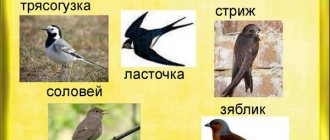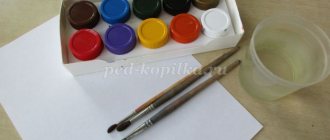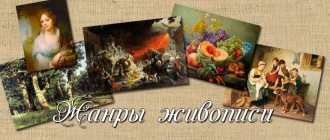- Reports
- Plants
- Dandelion
Among the many herbs, I would like to highlight one unusual plant that is very often found in nature - dandelion. Latin name Taraxacum. In Russian it was formed from the verb obdut.
These plants bloom in spring and sometimes in autumn. When dandelions fade, white balls appear instead of flowers - these are seeds. They are very light. The wind blows them in different directions. They grow in fields and meadows, vegetable gardens and wastelands, in gardens and forests. Everywhere you can see them in a beautiful bright outfit. They come in different colors: yellow, purple, lilac, dark green, with white petals and a yellow center. This miracle of nature lives as if according to a schedule: on sunny days, dandelions open at 6 o’clock, and at 15 o’clock they curl up. In cloudy weather they do not open at all. A folk sign says: “The dandelion ball shrinks - it will rain.”
And how many useful substances dandelion contains! These are rubber, potassium, manganese, iron, phosphorus, calcium, organic acids, resins, wax, many vitamins and even protein. In many countries, various foods are prepared from this plant, for example: salads from leaves pre-soaked in salt water, wine and beer, pickled and fermented, jam is made from the flowers. Whole dried plants are used to brew tea, and the dried and roasted root is used as a coffee substitute.
The Chinese call dandelion a vegetable and often prepare various dishes from it. Italians consider dandelion food to be their favorite food. They sow plants on huge plantations, then sell this crop in retail outlets. In restaurants and on Italian holiday tables you can see dishes made from this unique plant. Dandelion is a nutritious food for pets, and rabbits especially love to eat it.
This unique plant is also used in folk medicine. Use flower, stem, root, juice. They treat many different diseases. In France, dandelion leaves and root are used for liver diseases. Water tincture improves appetite and metabolism. The juice of the plant removes warts. Italians believe that by eating dandelion, the disease passes them by.
Dandelion is also used in cosmetology. Masks are made from the leaves to moisturize and rejuvenate the skin. And an infusion of flowers removes freckles and age spots.
The roots of many types of dandelions contain rubber. Plants are cultivated and made from
natural rubber, which is used in industry. Scientists in many countries are developing technologies for using dandelion juice to produce biological rubber.
In our country, dandelion is now a weed, but in other countries it is a cultivated plant, especially in China, France and Italy, where entire fields are sown with it. Holidays are dedicated to this culture. May 10 is World Dandelion Day.
Let us join in the celebration, and in the future we will use this unique plant for a variety of purposes.
Report on the topic Dandelion
Dandelion is a herbaceous, perennial plant. Comprises:
- sockets;
- basal leaves;
- rare flower stems.
The basal leaves reach up to 10 cm in length and 1.5 cm in width. The typical basal leaf is wider in relation to its outer tip than at the base in outline, although it is more or less lobed along its length. These blades are triangular. The fields are slightly undulating and irregular, and sometimes roughly jagged.
There is a central vein along the length of each leaf, which is hollow and contains milky sap. This vein is usually green, but sometimes it turns reddish-green towards the base.
The leaves are usually glabrous, although young leaves are sometimes slightly hairy.
The root system consists of a thick root rope, no more than 3 cm long. This root is slightly fleshy and contains milky juice. This plant propagates by transplantation. It can form large colonies.
Cultivation: preference is given to bright places and soil that consists of loam or clay loam. Partial sunlight is also tolerated. This plant can be very resilient and can regenerate itself from small pieces of the root.
Dandelion is a very common plant that takes its historical origin from the state of Illinois. It was exported to North America from Europe. Habitats include lawns, gardens, meadows, roadsides and railroad tracks. Dandelion has little opportunity to reproduce in scientific natural habitats, always preferring open areas that are disturbed and degraded by human activities.
The nectar or pollen from dandelion flowers primarily attracts bees, flies and butterflies. Dandelion leaves are edible and feed on caterpillars and many other types of insects. In the Eastern States and the Midwest, the seeds are eaten and considered a delicacy. While the foliage is somewhat bitter, it is consumed by a variety of herbivores, including livestock, rabbits, etc.
Young dandelion leaves are sometimes eaten fresh in salads. As the flower rosettes open, the foliage becomes more bitter and harsh. The leaves contain large amounts of vitamins and minerals. Sometimes flower rosettes are used to make jam. Most people consider dandelion to be a destructive weed, although the flowers are quite attractive. Because it can bloom very early or very late, the nectar or pollen of flower rosettes is a valuable food source for some pollinating insects, especially bees. There are species of dandelions that produce a rosette of leaves with flower stems that are composed entirely of yellow onion flowers.
Dandelion has the following characteristics that can be helpful in proper identification:
- the outer green bracts slope sharply downwards from the flowerbeds;
- from an empty flowering stem only one flower is formed.
Interesting facts and legends
Dandelion is a very interesting plant that was well known in ancient times. Thus, bright flower heads, resembling the sun, were held in special esteem by the Chinese, Slavic pagans and representatives of many other peoples and cultures. Interesting facts about culture don’t end there:
- In nature, there are not only yellow, but also cream, greenish and even pink dandelion flowers, the properties of which do not change depending on the color.
- The so-called Russian variety of the crop, which grows on the territory of the Russian Federation, is Dandelion officinalis, although other species of this class are also less common.
- Spring pollination of dandelions produces large quantities of honey with a beautiful golden or dark amber hue. But the taste of this product is not the best due to its pronounced bitterness.
- Dried dandelion leaves are one of the favorite treats of rabbits, mice, hamsters, chinchillas and other rodents.
- Plant extracts are actively used in cosmetology, having a powerful whitening and anti-pigment effect. In addition, using a mask made from fresh leaves of the plant will thoroughly moisturize the skin and rejuvenate it at the cellular level.
- More recently, a rubber-bearing variety of dandelions, which is endemic, was identified on the slopes of the Tien Shan. During the research process, it was proven that its roots contain about 20 percent of raw materials, so today the issue of breeding the variety for rubber extraction is being considered.
- It is no secret that dandelions are a malicious weed, which can only be gotten rid of by cultivating the soil with cutting tools during its active budding.
There are many interesting legends associated with the plant. For example, in Rus' it was believed that in ancient times the flower was valued by people and nature, giving them beauty and life to the bees who made honey from dandelion pollen. And so it lasted until an evil horde came to Russian land, enslaving all living things except the dandelion, which did not want to obey, hiding its flowers and hanging its head to the ground.
Over time, the evil forces left Rus', but the plant was never able to forget this horror, rising towards the sun's rays and immediately descending as soon as bad weather fell on the ground. For a long time, people told this and many other stories to their children, but after many years they were forgotten.
Dandelion - structure, development cycle
Dandelion - a perennial herbaceous plant with a fleshy taproot and a rosette of basal carved leaves - belongs to the family Asteraceae, that is, it has many flowers on one receptacle, and what is popularly called a dandelion flower is actually a whole inflorescence called basket.
The flower arrow is hollow like a tube, 10-30 cm high, sometimes up to 50 cm, ending in a single decorative golden-yellow basket. The fruits are fluffy achenes (each achene is equipped with a parachute).
As soon as the snow melts in spring, the “sun” appears among the emerald grass near houses, in gardens and fields. Then another, then another. And now at every step you can see these yellow dandelion heads. The main flowering of dandelion is in April-May, it can bloom until autumn. Dandelions bloom for 1-2 weeks, it depends primarily on the weather. One flower blooms one day, the next day it is already a ball of fluff. But the plant has many flowers, they bloom in turn.
The seed ripens in the dandelion in the achene a week after the end of flowering. When suitable weather arrives, each achene dissolves its villi and the former flower turns into a white fluffy ball. This kind of device allows the wind to tear off parachute fluffs along with seeds from the parent plant and carry them over long distances. If a seed lands on fertile soil, it “screws” into it and the development of a new plant begins.
Scientists have calculated that if all dandelion seeds germinate, then in just one season dandelion would cover several areas of the globe, since each plant produces about 3,000 seeds over a specified period. And with such a distribution mechanism, it is not difficult for seeds to find themselves in a new territory.
All organs of the plant contain white milky sap, which has a very bitter taste. Dandelion has a large root that goes far into the soil, reaching aquifers, and therefore can grow in dry, trampled places. Each piece of root can produce a new plant.
Properties of dandelion
Dandelion helps with chronic liver diseases, gallstones and kidney stones, atherosclerosis and inflammatory kidney diseases. Dandelion is also used for intoxication and poisoning, cholecystitis; liver cirrhosis; edema of various origins; low potassium levels; weak appetite, gastritis with low acidity; for joint diseases, atherosclerosis, etc.
Dandelion juice is one of the most valuable tonic and strengthening agents. It is necessary to neutralize hyperacidity and normalize the alkaline composition of the body. Raw dandelion juice, obtained from leaves and roots, combined with carrot juice and turnip leaf juice, helps with spinal ailments and other bone diseases, and also gives strength to teeth, thereby preventing periodontal disease and their destruction. Dandelion juice is obtained from the whole plant (in May - June) by crushing it and extracting with a small amount of water. The plant is first soaked in cold salted water (for 30 minutes) to reduce the bitter taste. Take 1/4 - 1 glass daily for a long time (you can use rice or oatmeal broth, with a tablespoon of honey). Dandelion juice can be preserved with alcohol or vodka.
The biologically active substances of dandelion also have choleretic, diuretic, antispasmodic, laxative, expectorant, sedative, hypnotic, diuretic, and diaphoretic properties. In addition, in the process of studying the activity of dandelion, antiviral, antituberculosis, fungicidal, anthelmintic and anticarcinogenic properties were also established.
The beneficial and medicinal (healing) properties of dandelion make it possible to use it for the treatment of diabetes, atherosclerosis, as a diuretic, for kidney stones and cholelithiasis, for anemia, anemia, as a wound-healing agent, in the treatment of paresis, paralysis, as an anthelmintic. Dandelion has antitoxic properties, stimulates the cardiovascular system, is used as an anti-radiation agent, and is useful in the treatment of arthritis and for removing warts. It is also used for inflammation of the skin, bites of poisonous insects, and lack of milk in a nursing mother. Such a variety of properties of dandelion makes it a valuable plant for stimulating performance, eliminating fatigue, fatigue.
Composition of dandelion
Edible dandelion leaves contain carotene, vitamin C, B2, choline, niacin, calcium, potassium, manganese, iron, phosphorus.
Dandelion leaves are a good anti-scorbutic remedy; they have a beneficial effect on the functioning of the digestive glands, kidneys, liver, and gall bladder. Its leaves and roots have long been widely used in folk medicine to stimulate appetite, for stomach catarrh, as an expectorant and diuretic. Young leaves and roots of dandelion are used as food.
Dandelion! Why, you look like a cloud!
Short poems about dandelion for children 3-4 years old
***
Along the path, a dandelion dropped its yellow sundress. Became fluffy, like fluff: - Brothers! How swollen I am! N. Turovaya
***
I was the Radiant Sun. I became a Fluffy Cloud.
***
Dandelion! How much do you look like a cloud? It’s scary even to look: No matter how much the cloud blows away! G. Vieru
***
The yellow dandelion took off his sundress, and replaced his boring dress with a white, airy one. N. Nekhaeva
***
I am a dandelion, a sunny boy, reaching for the sun with my golden head. With a fair wind On a parachute I can even fly around the globe!
***
Under the fence, on the lawn According to the latest style, Dandelion grew and grew. I feel sorry for him to the point of tears - The wind carried away his hat. T. Andreeva
***
The dandelion has grown round, the dandelion has fluffed up! I had a green sundress and changed into a fur coat overnight! It’s very hot in the summer in a fur coat, The breeze helped the flower: It flew over, leaving it in the skirt - It will only be chilly at night. A. Weiner
***
The breeze got wild: It blew strongly, skillfully... And the white dandelion took flight! N. Melnik
***
The cheerful and funny Yellow DANDELION opened its bright caftan under the bright sun. M. Blinnikova
Dandelion
The cat saw a fluffy sunbeam right next to the path. The baby shakes her carved palm, Laughs - No, I’m M. Blinnikov’s dandelion
We are changing
White dandelion, land here! Take my ball, Give me your parachute! A. Pysin
Umbrellas
— How to make three hundred umbrellas? The boy asked his mother. She answered him: “Blow on a dandelion.” R. Seph
What is the dandelion thinking about?
If you believe and dream, if you are obedient, then over the summer you can become a balloon! Yu. Kushak
Poem about a wreath of dandelions
***
How many dandelions are in yellow sundresses! They circle around the clearing and are very friendly with the sun. We will weave wreaths from them for both mother and daughter. N. Golubeva
Dandelion, the whole world, round like the earth...
Dandelion poems by Russian poets may be a little challenging for your little ones, but older children will appreciate the beauty of the poetic lines.
***
June has arrived. "June! June!" — Birds are chirping in the garden. Just blow on a dandelion and it will all fly away. Samuel Marshak
***
... Moment after moment, star-shaped snowflakes curl in the Sky, Fall with the wind to the Earth, and lie like a white layer, But snowflakes cherish a dream, then - flower fluffs, Delicate, fresh dandelion with wet Spring. K. Balmont
Gray dandelion
Dandelion, the whole world, Round as the earth, You call me to a feast, Silver fields.
You will turn grey, you will fade, you will all fly away. But melancholy and fears are lies, Happiness is forever here.
You will turn grey, but grey-haired Remember your turn. You will be golden again, In the morning, in a year. K. Balmont
Dandelion
Here they are! Silently, silently, the roots prepare white juice, the hollow stem is fed with bitter milk.
And again, silently, silently, They skillfully close, And under the red cap, a white holiday is ripening.
All yards will be renewed, every single lawn. Beautiful balls, Cheerful gray hairs.
A light sigh or a breeze - Pooh flies after a handful of handfuls. And a circle will remain, like a thimble. V. Berestov
Dandelion
Parachutists Made of fluffy balls Over a colorful summer meadow Parachutists are flying, chasing each other. As soon as they touch the ground, they fall asleep, as if on a sofa. And in the spring they will wake up... And there will be dandelions! I. Tokmakova
Dandelion
The roadside dandelion was like the golden sun, but it faded and became like fluffy white smoke.
You fly over a warm meadow and over a quiet river. I will wave my hand after you for a long time, as a friend.
You carry Golden seeds on the wings of the wind, So that spring will return to us with a sunny dawn. V. Stepanov
Dandelions
A girl in a green sash fussed about, planting two yellow plantings on the sand.
They don’t even hold on: Isn’t the sand happy for them? And the sun is already in the west and the garden is golden.
“Nasty, stubborn!” - Be silent, little daughter, If the pits are unpleasant to them, We will send the stems away to them.
You see: everything is for the better - Child, have fun, Along the shifting hill Two stars lit up.
Shaggy, saffron stars made of flowers... Well, my beloved, And your garden is ready.
The little legs will jump off, the laughter will pour out, and the night will come - the little god has beds for everyone...
You will fall asleep, angel-girl, in fluff, on your elbow... And two yellow ones are spread out in the sand.
Dandelion - predictor
Dandelion can predict the weather. How he does it? How can one predict the weather if one cannot speak?
In dry, clear weather, from the very early morning, the inflorescence blooms, exposing its petals to the sun and creating conditions for pollination, and with the onset of dusk, or if the weather becomes cloudy, rainy, the dandelion hides its flowers, folding like an umbrella
Using the ability of flowers to “orient themselves in time,” Carl Linnaeus created the world’s first flower clock in 1720 (Switzerland). The dial of this watch consisted of several sectors with different types of flowers. With the help of such watches it was possible to determine time quite accurately. The only drawback was that they only worked in sunny weather.
In dry weather, dandelion baskets open between 5-6 am and close by 8-10 pm. Dandelions love the sun and turn their heads after it.






